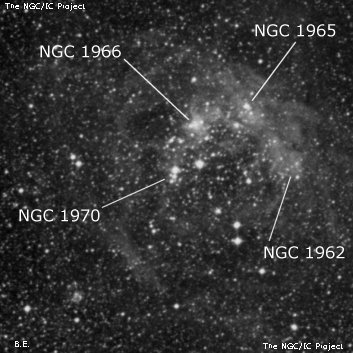
John Herschel discovered NGC 1970 = h2869 on 31 Jan 1835 and recorded "The last nebula in the group of four [with NGC 1962, 1965 and 1966] with stars. Place concluded (with no precision) from the 1st and 3rd by the aid of a diagram." [Plate VI, fig 20]. Despite his uncertainty with the position, it is pretty accurate. Dunlop discovered the entire group (D 136 = S-L 476) and described "a faint confused pretty large nebula. There are a multitude of small nebulae in this place." His position is ~10' too far SW (typical error), though he did not distinguish individual components. Herschel noted the possible equivalence with D 136.
The complex was also sketched by Joseph Turner in Dec 1875 using the 48" Great Melbourne Telescope (plate III.30 at www.docdb.net/history/texts/1885osngmt________e/lithograph_m_3_30.php). His sketch shows the three stars oriented NNW-SSE with no nebulosity, but there is a patch of nebulosity surrounded by a ring of stars that is sketched close north. Pietro Baracchi also took this group of four or five stars as GC 1175 = NGC 1970.
600/800mm - 24" (4/7/08 - Magellan Observatory, Australia): at 200x; NGC 1970 is at the SE corner of the NGC 1962-65-66-70 complex (stellar association LH 58). It consists of three close collinear stars oriented NNW-SSE with the brightest mag 10.8 star at the north end. Using a UHC filter, the stars were surrounded by only very weak nebulosity that was no more prominent than the general field haze. HD 269546 = Brey 34, a mag 9.9 Wolf-Rayet binary (WN5+B3) and the brightest individual star in the complex, is just 0.7' WNW of the 3 stars.
Notes by Steve Gottlieb